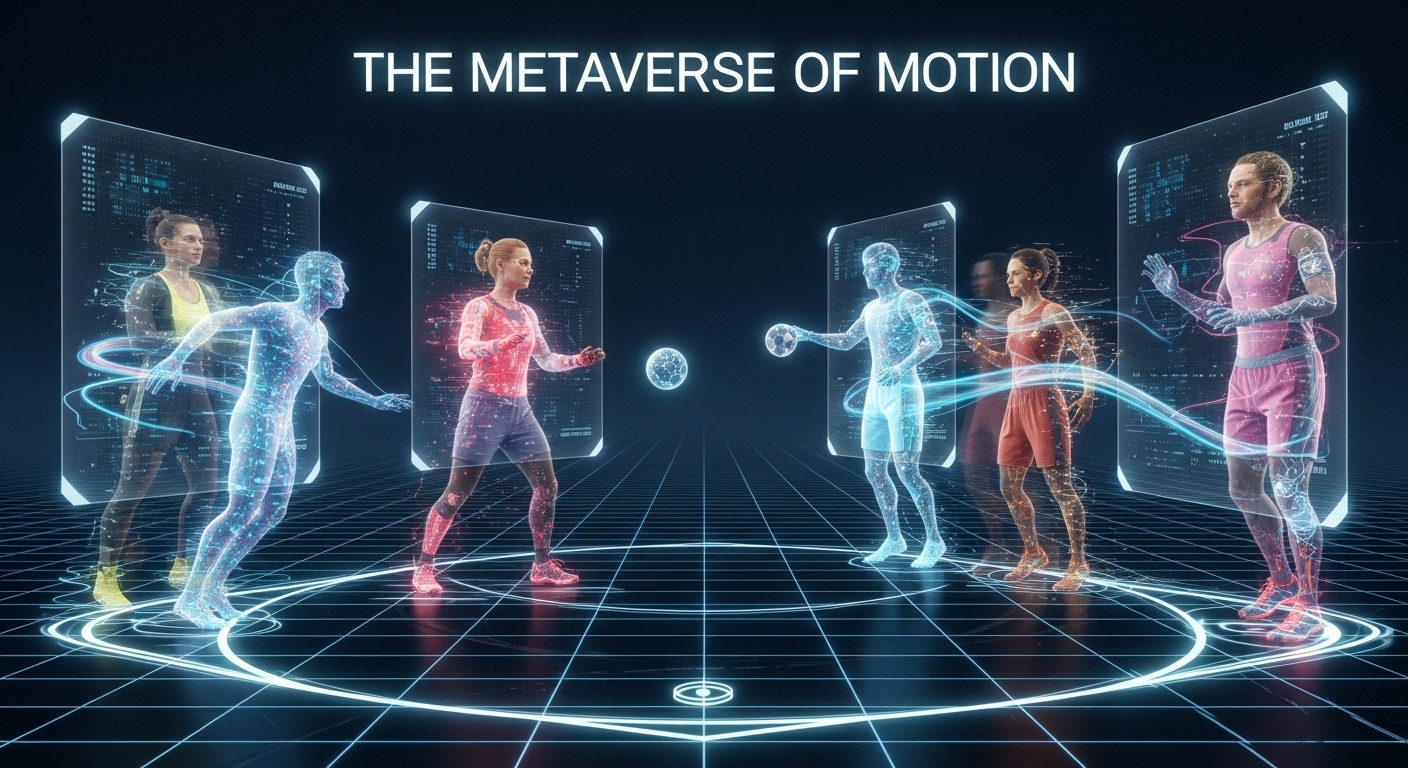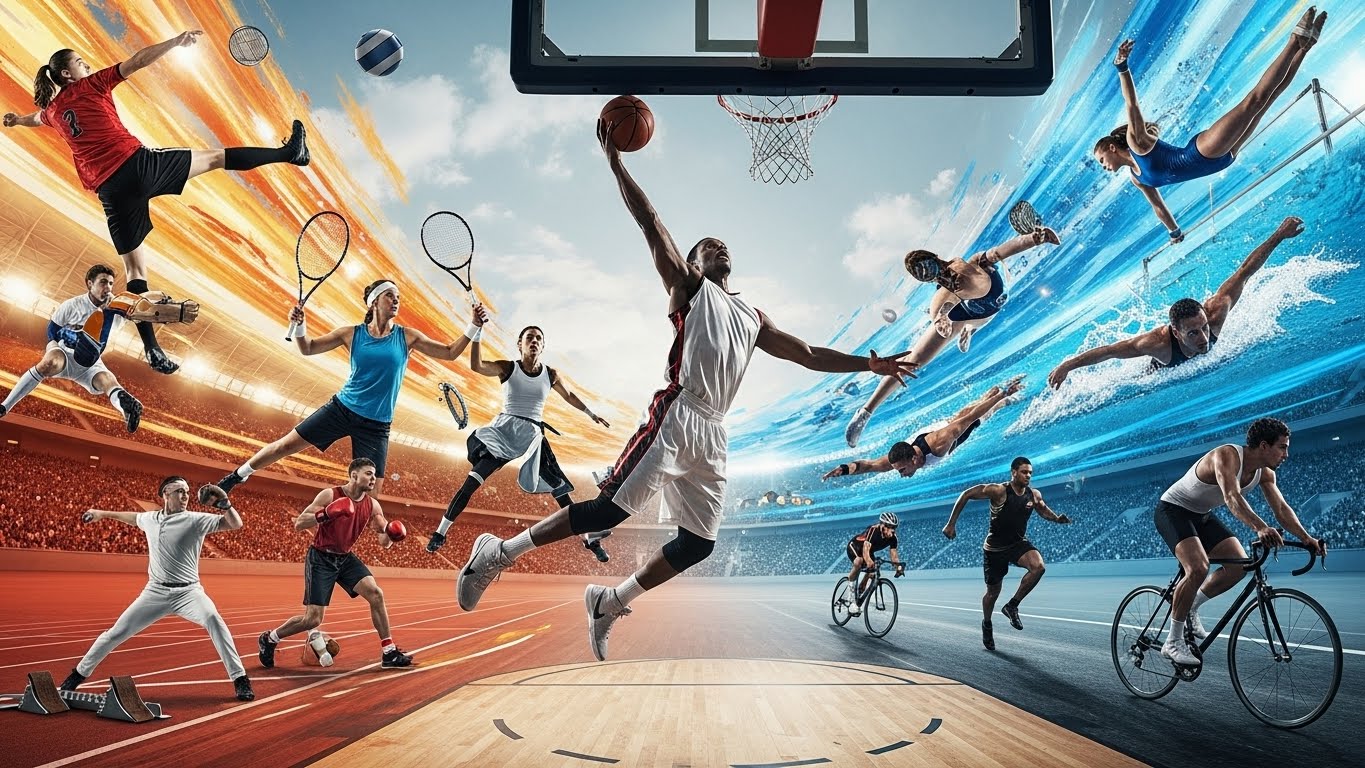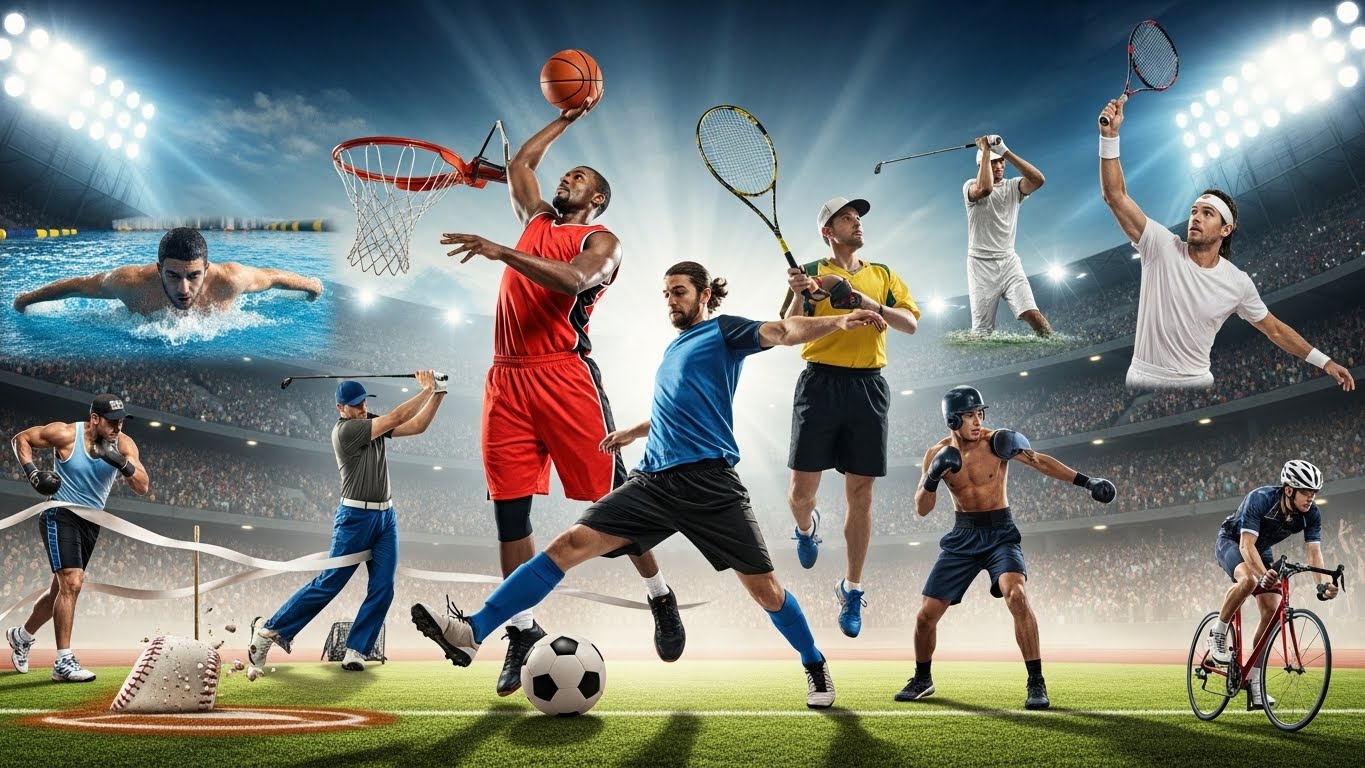Introduction
Sports have always been more than mere games. They are a reflection of human strength, endurance, creativity, and the eternal pursuit of excellence. From ancient civilizations hosting primitive contests to today’s multi-billion-dollar global sporting industry, the journey of sports tells a powerful story about humanity itself. It is a journey that intertwines culture, politics, technology, and emotion, shaping not only our societies but also our identities.
In every corner of the world, sports unite people beyond boundaries of language, race, and nationality. Whether it’s a village football match, the Olympic Games, or a world championship event, sports carry the power to inspire millions. But how did we get here? What forces shaped the games we play and celebrate today? Let us explore the fascinating evolution of sports — from its ancient roots to its modern-day prominence.
The Origins of Sports in Ancient Civilizations
The history of sports can be traced back thousands of years to the dawn of human civilization. Early humans relied heavily on physical strength and agility for survival. Hunting, running, and wrestling were not just skills — they were essential activities that later evolved into organized forms of competition.
Sports in Ancient Egypt
In ancient Egypt, sports were deeply intertwined with religion and daily life. Archaeological evidence from tombs and temple walls reveals depictions of wrestling, swimming, archery, and even weightlifting. Pharaohs and nobles often participated in hunting expeditions, which were seen as demonstrations of courage and leadership. The Egyptians also practiced a form of stick fighting known as “tahtib,” which is still performed today as a cultural tradition.
The Greek Legacy
No discussion about ancient sports would be complete without the Greeks. Ancient Greece is widely regarded as the birthplace of organized sports. The Greeks introduced the Olympic Games in 776 BC, a tradition that would inspire the modern Olympic movement thousands of years later. The games were dedicated to Zeus and held in Olympia, featuring events such as running, wrestling, discus throwing, and chariot racing.
For the Greeks, sports were not just entertainment but a form of worship and a test of moral character. Athletes trained under strict discipline and were celebrated as heroes. The idea of the “perfect body” and the harmony between physical and mental excellence became central to Greek philosophy and education.
The Roman Influence
The Romans inherited much from the Greeks but added their own flair for spectacle. Roman sports were often grand and brutal, designed to entertain massive crowds. Gladiatorial combats, chariot races, and mock naval battles filled the colossal amphitheaters of Rome. Although these events sometimes involved violence, they also reflected Roman ideals of bravery, honor, and competition.
Sports in the Medieval and Renaissance Eras
After the fall of the Roman Empire, organized sports declined in Europe during the early medieval period. However, many traditional games and martial activities continued in local communities and royal courts.
The Age of Knights and Tournaments
During the Middle Ages, sports took on a more militaristic tone. Knights engaged in jousting tournaments and sword fighting to demonstrate valor and prepare for battle. Hunting remained a popular pastime among nobles, while common folk played games such as archery, wrestling, and early forms of football.
These tournaments were not merely physical contests; they were major social events that displayed wealth, status, and power. The code of chivalry influenced the behavior of participants, reinforcing ideals of honor and respect.
The Renaissance: A Revival of Humanism and Physical Culture
The Renaissance brought renewed interest in the human body and classical ideals. Education began to include physical training, inspired by Greek and Roman philosophies. Activities such as fencing, dance, and gymnastics gained prominence among the European elite. The concept of sportsmanship — the idea of playing fair and respecting opponents — also began to take root during this time.
The Birth of Modern Sports
The transition from traditional to modern sports began in the 18th and 19th centuries, particularly in Europe. This era was marked by industrialization, urbanization, and the rise of leisure time. Schools and universities started formalizing rules for various games, leading to the birth of many sports as we know them today.
The British Contribution
Britain played a central role in shaping modern sports. Football (soccer), cricket, rugby, tennis, and golf all owe much of their modern structure to British society. Public schools such as Eton and Harrow codified rules and established organized competitions. By the late 19th century, Britain’s global empire helped spread these sports around the world.
Cricket became a symbol of fair play and gentlemanly conduct, while football captured the imagination of the working class. The establishment of clubs, associations, and governing bodies such as The Football Association in 1863 formalized the organization of sports.
The Olympic Revival
In 1896, the modern Olympic Games were revived by Pierre de Coubertin, inspired by the ancient Greek tradition. The first modern Olympics were held in Athens and featured 13 nations. The revival of the Olympics marked a turning point in the globalization of sports, promoting international friendship and competition.
Sports in America
In the United States, the late 19th and early 20th centuries saw the rise of baseball, basketball, and American football. These sports became symbols of American identity and community spirit. Baseball, often called “America’s pastime,” captured the nation’s imagination with its blend of strategy, skill, and simplicity. Basketball, invented by James Naismith in 1891, rapidly spread across schools and became one of the world’s most popular sports.
The Globalization of Sports
As the 20th century progressed, sports evolved from local pastimes into global phenomena. Advances in transportation, communication, and media allowed fans worldwide to follow their favorite teams and athletes. The birth of television in the mid-1900s revolutionized the way people experienced sports.
The Role of Media
Television turned athletes into household names. Events like the World Cup, the Olympics, and the Super Bowl became cultural landmarks. Commentators, replays, and live broadcasts brought a new level of excitement to fans everywhere. The emotional power of sports was amplified, and advertising soon followed, making sports a lucrative industry.
Sports and Politics
Sports have often intersected with politics. The 1936 Berlin Olympics, for instance, were used by Nazi Germany to project its ideology, though the triumph of African-American athlete Jesse Owens sent a powerful message against racism. Similarly, the Cold War era saw the Olympics as a stage for political rivalry between the United States and the Soviet Union.
Boycotts, protests, and symbolic gestures — such as the Black Power salute at the 1968 Mexico City Olympics — demonstrated that sports could be a platform for social change and political expression.
The Rise of Professionalism
The late 20th century marked the dawn of full-time professional athletes. Sponsorships, endorsements, and commercial contracts transformed sports into one of the world’s most profitable industries. Athletes became global icons, influencing fashion, lifestyle, and even politics.
The Business of Sports
With television rights, sponsorship deals, and merchandise sales, sports became a billion-dollar enterprise. Major leagues such as the NBA, NFL, Premier League, and Formula 1 expanded their reach across continents. Stadiums became architectural marvels, while sports apparel brands fueled new waves of marketing innovation.
The Cult of the Superstar
Names like Pelé, Muhammad Ali, Michael Jordan, Serena Williams, and Lionel Messi became synonymous with greatness. These athletes transcended their sports, embodying excellence, perseverance, and charisma. Their influence extended beyond the playing field, inspiring generations and shaping cultural movements.
Women in Sports: Breaking Barriers
For much of history, women were excluded from organized sports. However, the 20th century saw a revolutionary change. From the suffragette movement to feminist advocacy, women gradually claimed their place in the sporting world.
Early Challenges
In the early 1900s, women faced social and institutional barriers. Many believed that sports were too strenuous or inappropriate for women. However, pioneers like Suzanne Lenglen in tennis and Babe Didrikson Zaharias in athletics defied these norms and proved that female athletes could compete at the highest levels.
A New Era of Equality
The passage of Title IX in the United States in 1972 marked a watershed moment, mandating equal opportunities in school sports. Women’s participation soared, leading to the rise of legendary figures such as Billie Jean King, Mia Hamm, and Serena Williams. Today, women’s sports continue to gain recognition and investment, with record-breaking viewership in events like the FIFA Women’s World Cup.
Technology and Innovation in Modern Sports
Technology has revolutionized every aspect of sports — from training and equipment to broadcasting and fan engagement.
Data and Analytics
Modern athletes benefit from precise data analysis, wearable technology, and advanced biomechanics. Coaches use analytics to assess player performance, predict outcomes, and prevent injuries. This data-driven approach has elevated the level of competition to unprecedented heights.
Equipment and Safety
From carbon-fiber bicycles to aerodynamic swimsuits, technological innovation has enhanced performance and safety. In motorsports, for instance, the development of crash-resistant vehicles and smart helmets has saved countless lives. Even traditional sports like tennis and football now use technology for fairer officiating — such as VAR and Hawk-Eye systems.
Virtual Reality and Esports
In recent years, virtual reality and esports have emerged as major trends. Esports, or competitive video gaming, has created a new form of digital athleticism. Millions of players and spectators participate in tournaments that rival traditional sports in popularity and revenue. The line between physical and virtual competition continues to blur, opening new frontiers for the future.
The Spirit and Impact of Sports
Beyond records and trophies, sports hold deeper meaning. They teach discipline, teamwork, and resilience. They inspire unity during global crises and provide hope in times of despair.
Social Impact
Sports have the power to break down barriers and bring communities together. Initiatives promoting inclusivity, disability sports, and youth engagement continue to grow worldwide. The Paralympic Games, for example, celebrate the incredible achievements of athletes with disabilities, challenging stereotypes and redefining the limits of human potential.
Mental Health and Well-Being
Sports also play a vital role in promoting mental health. Participation in physical activity reduces stress, boosts confidence, and fosters social connection. Many athletes today openly discuss mental health challenges, helping to destigmatize these issues and inspire others to seek help.
The Future of Sports
As we move deeper into the 21st century, the world of sports faces new challenges and opportunities. Sustainability, inclusivity, and technological integration will shape the next generation of competition.
Sustainability and the Environment
Major sporting events now prioritize eco-friendly practices. From solar-powered stadiums to carbon-neutral tournaments, the industry is recognizing its environmental responsibility. Sports organizations are also using their platforms to raise awareness about climate change and sustainability.
Diversity and Inclusion
The future of sports will be more diverse than ever. Efforts to ensure gender equality, support LGBTQ+ athletes, and promote accessibility are transforming the cultural landscape. The idea that sports belong to everyone, regardless of background or identity, is gaining global traction.
AI and the Digital Revolution
Artificial intelligence, virtual training, and advanced analytics will continue to redefine athletic performance. Fans can expect more immersive viewing experiences, real-time interaction, and personalized content. The fusion of sports, entertainment, and technology will create a new era of engagement.
Conclusion
From the dusty arenas of ancient Olympia to the dazzling stadiums of today, the story of sports is a story of humanity’s unending pursuit of greatness. It mirrors our struggles, triumphs, and evolution as a species. Sports have transcended borders, languages, and generations — inspiring hope, unity, and courage in every corner of the globe.
In the modern world, sports are more than a pastime. They are a universal language of emotion, passion, and perseverance. They remind us that excellence is not confined to victory but lies in the spirit of participation, effort, and respect.
As we look to the future, one truth remains eternal: the essence of sports — the joy of play, the thrill of competition, and the celebration of human potential — will continue to shape the world for centuries to come.



